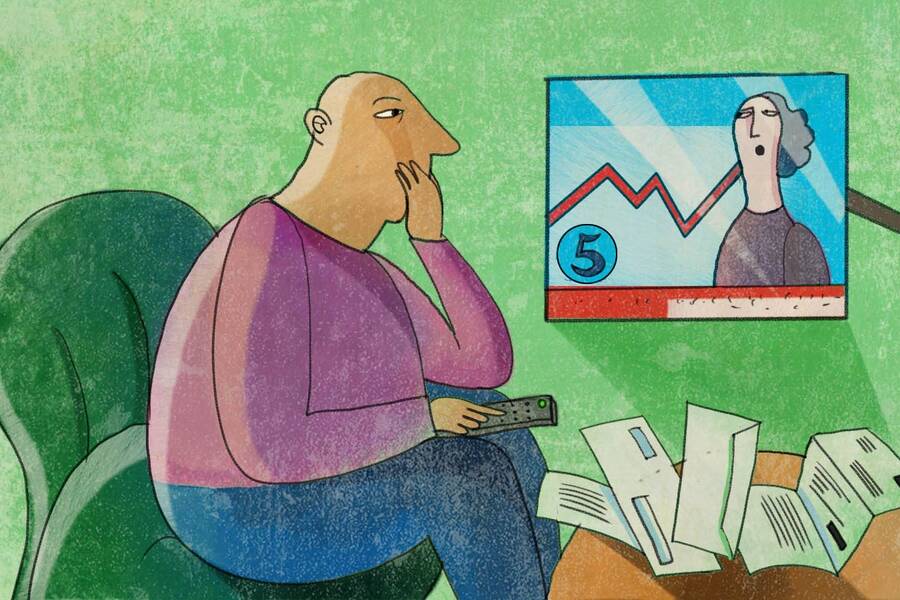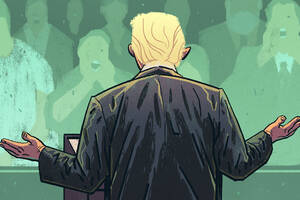
Michael Meier
One of the prevailing feelings during the pandemic—in addition to straight up fear, of course—was uncertainty. There were many, many months where we didn’t know what to expect. Would the vaccines work? Would a new variant cause a surge? Would schools and offices reopen? And how would all of this uncertainty impact the economy?
While this particular brand of uncertainty was very new, uncertainty about the future of the economy is a recurring condition and is something that Scott Baker, an associate professor of finance at Kellogg, studies.
Pervasive uncertainty about the future of the economy can cause people to defer making decisions until a clearer picture takes shape. Faced with a rumored tax hike, for instance, or a close election between ideologically different candidates, the economy tends to slow down. Businesses may hold off on planned investments until the outcome of the tax hike or election is known. Similarly, individuals defer their own big purchases.
Because of these widespread consequences, economists have long been interested in measuring ever-fluctuating levels of “policy uncertainty”: uncertainty about which government policies may be enacted or how they might impact the economy. Knowing that policy uncertainty is high could help predict how consumers and businesses will respond, and allow policymakers to intervene, for example.
But Baker believes these measures stand to be improved. As he points out, current measures of policy uncertainty—including the ones he has developed—focus on the impact of national laws, in the U.S. and elsewhere. But in the U.S. especially, that ignores a large group of crucial policy players: state and local lawmakers.
“If you think about the response of households and businesses to different sources of policy uncertainty, a lot of that is coming from the state and local level,” Baker says. In the U.S., he adds, states have an especially wide berth to establish their own policies concerning local taxation, education, energy, the environment, public health, and more. That means it’s crucial to be able to untangle the economic uncertainty that’s generated from national laws from that sparked on the more local level.
In order to do just that, Baker has built on his previous research to create new measures of economic-policy uncertainty—this time, trained on individual U.S. states.
Baker and his fellow researchers—Steven J. Davis and Jeffrey A. Levy, both at the University of Chicago—built three monthly indexes to follow different sources of economic-policy uncertainty within individual states. One index tracks uncertainty coming from state-level policies (EPU-S, for short), one tracks uncertainty from national and international policies (EPU-N), and another integrates state, local, national, and international uncertainty into a composite index (EPU-C).
Analyzing these three types of economic policy uncertainty in each state allows the researchers to better understand local trends—such as how high levels of economic uncertainty in a particular region foreshadow high rates of unemployment. It also allows them see how national shocks—such as the coronavirus pandemic—play out on a local level.
“Using these tools, it becomes much easier to figure out what the impacts of those local and state policies are and how they differ from national policies,” Baker says.
Following the News
The researchers use newspaper articles to build their indexes. Newspapers are uniquely helpful measures of forward-looking uncertainty, the researchers point out, and because they’re generally published daily or weekly, they allow for a frequent refresh of policy uncertainty levels.
To build their EPU indexes, Baker and his colleagues pulled from roughly 3,500 papers via the Access World News Newsbank archives. The period they tracked ran from January 1985 to the present, though it was shorter for many states.
Each of the indexes was designed to flag articles that include a specific combination of keywords: “economic” or “economy,” plus some version of “uncertain” or “uncertainty,” plus at least one term that specifically signifies either a national or state/local policy. For example, “monetary policy” would point to the national-policy category, as would terms for federal offices, like “Congress.” On the other hand, “zoning” categorizes an article as related to state and local policies—so do “governor,” “mayor,” and “city council.” The researchers consulted government websites for local officials’ titles and for the names of local and state bodies that oversee transportation, labor and unemployment, the environment, banking, and the like.
“The pandemic had a lot of effects on the economy, on behavior, and on perceptions of uncertainty. But the government responses, in some cases, have magnified that.”
— Scott Baker
Predictably, the EPU-S indexes jump disproportionately around gubernatorial elections and state-specific news like the California electricity crisis in 2000 and 2001, while the EPU-N measure spikes around presidential elections and national news like the terrorist attacks on September 11, 2001.
The Pandemic’s Impact on Uncertainty
The state-level indexes reveal how differently states have experienced policy uncertainty over the past four decades.
“There are definitely common shocks,” Bakers says, “but there’s also a lot of idiosyncratic variation that we thought would be useful to highlight.”
For example, in some states, local sources of policy uncertainty registered much more heavily than national sources, as was the case in Alaska and Wyoming, while the opposite appeared to be true in other places, like Washington, D.C.
What was clear across the board, however, was the unprecedented impact of the coronavirus on the economic-uncertainty measures.
All of the indexes registered the shock: the EPU-N jumped to 2.7 times its pre-COVID peak and the average EPU-S to four times its previous high. Most notably, for the first time in the almost-four decades captured by the indexes, the main generators of policy uncertainty were at the state and local, rather than national, levels. The ratio of EPU-S to EPU-N for the average state rose from 0.65 pre-pandemic to 1.1 between March 2020 and June 2021—revealing the new, heavy weight being placed on local policies and the many questions about what form they would take and how long they’d last.
“The amount of power and the amount of novel legislation that was being passed by state and city and local actors was pretty unprecedented,” Baker says. “That came through very, very strongly in our measures. You really saw this inversion of the usual ordering—where uncertainty had been mostly governed by national actions on average—to one where everything was hinging on local actors.”
Baker adds that this inversion still holds, over two years after the coronavirus burst onto the scene. He and his colleagues will continue to monitor the EPU indexes and post updates roughly every six months on their website.
The EPU indexes are important to track in part because of how they presage very real economic responses. The researchers found that a given state’s spike in uncertainty generally foreshadowed higher unemployment rates there—with the worst of the unemployment generally peaking one year later.
“Uncertainty typically precedes bad economic times—this has been shown at national levels and across nations,” Baker says. “We show that the same patterns hold at the state level as well.”
They also showed that during the pandemic, spikes in uncertainty, and the economic contractions that tended to follow, were closely tied to state and local policies—even more so than to the coronavirus death toll in a given state. States with stricter lockdowns had bigger leaps in policy uncertainty, as well as larger increases in unemployment. In other words, it seemed to be the policies themselves, even more than the severity of the virus, that were most responsible for stoking economic uncertainty.
Addressing the Unknown
These findings suggest to Baker that, even in the midst of a public-health crisis, there are steps governments can take to mitigate uncertainty and its negative consequences.
“The pandemic had a lot of effects on the economy, on behavior, and on perceptions of uncertainty,” Baker says. “But the government responses, in some cases, have magnified that.”
He points out that, in Chicago and Illinois for example, some of the complaints about COVID-related policies have focused on the inability of the public to understand which indicators officials have used to determine when schools, businesses, and workplaces could open and when other restrictions would be lifted.
“Some of this is certainly unavoidable given the nature of the pandemic,” Baker says, “but I don’t think that all politicians fully appreciate the extent to which households and businesses need some information to be able to plan. And there are a lot of real costs associated with these levels of uncertainty, regarding what the business conditions are going to be in the future.”
Katie Gilbert is a freelance writer in Philadelphia.
Baker, Scott, Steve Davis, and Jeffrey Levy. 2021. “State-Level Economic Policy Uncertainty.” Working paper.



